
There is plenty of advice available about how to avoid being nervous.
For instance: we can be feel less nervous by breaking big tasks down into actionable steps.
In fact, there’s a whole industry of bloggers and app developers to help us feel more prepared and in control. The thing that doesn’t get a lot of press is how to deal when things are out of control (you know, like most of the time).
I often feel nervous. Even an organizational black belt will sometimes find themselves with sweaty palms and a quickening heartbeat.
I might be walking briskly across midtown, rushing to get to an appointment or worrying about a large presentation later that evening: my thoughts are thunderously loud and I barely detect the heat from traffic and smell of the Halal carts up Sixth Avenue.
It’s disorienting as I flit from one worry to the next.
But my body is present. It’s here with me, on the sidewalk at 55th Street, dense and humming with energy: I feel a tightening in my throat, a trickling nervous energy in my stomach. Parts of my body have contracted in response to my thoughts. But, the more I ignore my body, the louder my physical symptoms eventually become.
This is my opportunity. When anxiety occupies my mind, I return to my body as a reliable fixture in the present moment. My thoughts may be all over the place, accusing me of laziness or foolishness, but my body is substantial and real. It’s always here.
In fact, the squirming and contractions in my body become a trail of bread crumbs back to sanity.
How I Relate to Being Nervous.
(Note: you can practice any of these steps independently: you don’t have to do them all.)
1) I Acknowledge my mind and body: I’m in a spin cycle of anxious thoughts.
2) Embody: I feel my body (uncomfortable as it may be). What if I include my heart? How is this aching organ?
3) Expand: I see my environment, hear sounds around me. I imagine all the space around my body. I experience a wider world than just the problem I’m thinking about.
4) I drop my agenda (at least for a few moments): I give myself permission to stop the endless scheming and plotting. I don’t have to know what to do next.
The edge on my anxiety is softened and instead of desperately seeking solutions, and really just thinking the same ideas over and over again, I’m energized. I free myself from spinning endless scenarios in my head.
Am I completely calm?
No way!
The cure for being nervous is not fighting it.
It’s normal to want to feel the opposite or complete absence of whatever uncomfortable thing we are feeling.
But in my experience, we can’t pull a 180° on our feelings, so much as we can connect to their underlying non-neurotic power. For instance, underneath anxiety is often a recognition that we need more balance. Perhaps we need more time for ourselves or just need to put less pressure on ourselves to be perfect. In my case, I know that sometimes my anxiety is being driven by an excited part of myself that would like to do a hundred things at once.
But unless we are willing to acknowledge the physical component of anxiety, we will usually keep spinning our wheels, thinking that our wellbeing rests in future decisions we need to make.
We can view fear as a call to be more present. Our sensitive and often uncomfortable bodies actually reside in the present moment, as opposed to a world of hypotheticals in our mind. We can be reminded that all people—even Halle Berry—experience fear.
“My whole life I’ve had the fear that I was going to be abandoned.” ~ Halle Berry
By being willing to feel our fear, at least for a few moments, we will be better able to weather the everyday experience of not knowing what’s ahead. We might uncover an aspect of our own wisdom and equanimity that does not depend on naming the future.
Try one or all of the four steps above, and let me know how it goes.
~
Author: Dan Cayer
Image: Unsplash/Matt Evan
Editor: Ashleigh Hitchcock






Read 0 comments and reply